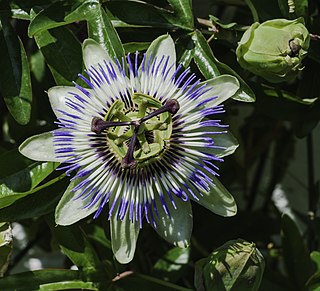
Passiflora caerulea, the blue passionflower, bluecrown passionflower or common passion flower, is a species of flowering plant native to South America. It has been introduced elsewhere. It is a vigorous, deciduous or semi-evergreen tendril vine growing to 10 m (33 ft) or more. Its leaves are palmate and fragrant, flowers blue-white with a prominent fringe of coronal filaments in bands of blue, white, and brown. The ovoid orange fruit, growing to 6 cm (2 in), is edible but bland.

Acantholimon is a genus of small flowering plants within the plumbago or leadwort family, Plumbaginaceae. They are distributed from southeastern Europe to central Asia and also in South America, but also cultivated elsewhere in rock gardens.
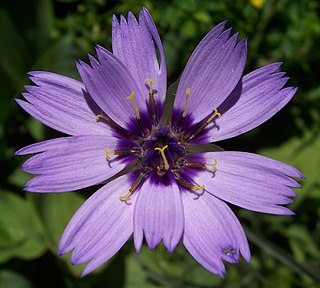
Catananche caerulea, Cupid's dart, is a greyish green perennial herbaceous plant with a basal leaf rosette and conspicuous blue-purple or sometimes white flowerheads, belonging to the daisy family. It is a popular garden plant and is often used in dried flower arrangements.

Lonicera caerulea, also known by its common names blue honeysuckle, sweetberry honeysuckle, fly honeysuckle, blue-berried honeysuckle, haskap, or the honeyberry, is a non-climbing honeysuckle native throughout the cool temperate Northern Hemisphere in countries such as Canada, Japan, Russia, and Poland.
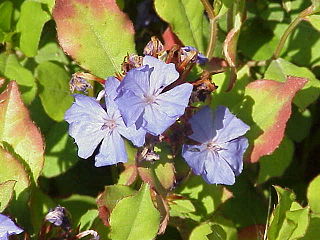
Ceratostigma (;), or leadwort, plumbago, is a genus of eight species of flowering plants in the family Plumbaginaceae, native to warm temperate to tropical regions of Africa and Asia. Common names are shared with the genus Plumbago.

Moenchia is a genus of plants in the family Caryophyllaceae with three species native to the Mediterranean region of southern Europe and naturalised in southern Africa and parts of North America and Australia. They are herbs, with an annual life span. They have slender roots and thin stems that are upright or ascending. Inflorescences are one- to three-flowered and terminally end the stems. The flowers are in spreading cymes or solitary, with bracts paired that are leaf like. Named after the 18th century German botanist Conrad Moench. A common name for the plants in this genus is upright chickweeds.
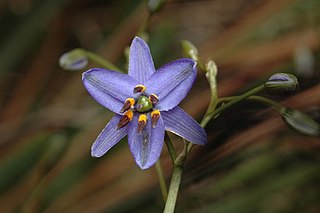
Dianella is a genus of about forty species of flowering plants in the monocot family Asphodelaceae and are commonly known as flax lilies. Plants in this genus are tufted herbs with more or less linear leaves and bisexual flowers with three sepals more or less similar to three petals and a superior ovary, the fruit a berry. They occur in Africa, South-east Asia, the Pacific Islands, New Zealand and Australia.

Plumbago auriculata, the cape leadwort, blue plumbago or Cape plumbago, is a species of flowering plant in the family Plumbaginaceae, native to South Africa.
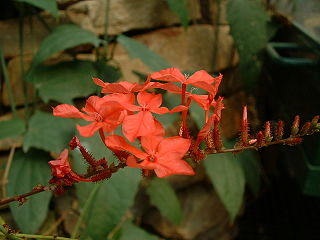
Plumbago indica, the Indian leadwort, scarlet leadwort or whorled plantain, is a species of flowering plant in the family Plumbaginaceae, native to Southeast Asia, Indonesia, the Philippines, and Yunnan in southern China.
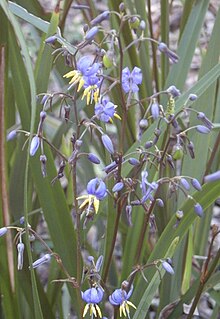
Dianella caerulea, commonly known as the blue flax-lily, blueberry lily, or paroo lily, is a perennial herb of the family Asphodelaceae, subfamily Hemerocallidoideae, found across the eastern states of Australia and Tasmania. It is a herbaceous strappy perennial plant to a metre high, with dark green blade-like leaves to 70 cm long. Blue flowers in spring and summer are followed by indigo-coloured berries. It adapts readily to cultivation and is commonly seen in Australian gardens and amenities plantings.

Azaleatin is a chemical compound. It is an O-methylated flavonol, a type of flavonoid. It was first isolated from the flowers of Rhododendron mucronatum in 1956 and has since been recorded in forty-four other Rhododendron species, in Plumbago capensis, in Ceratostigma willmottiana and in Carya pecan. It has been also been found in the leaves of Eucryphia.
Passion fruit woodiness virus (PWV) is a plant pathogenic virus in the genus Potyvirus and the virus family Potyviridae. Like other members of the genus Potyvirus, PWV is a monopartite strand of positive-sense, single-stranded RNA surrounded by a capsid made for a single viral encoded protein. The virus is a filamentous particle that measures about 745 nm in length.
Ein Nymphit is a small nature reserve northwest of Tel Afek, south of Kfar Masaryk, Israel.

Plumbago zeylanica, commonly known as Ceylon leadwort, doctorbush or wild leadwort, is a species of plumbago with a pantropical distribution. Carl Linnaeus described the paleotropical P. zeylanica and Neotropical P. scandens as separate species, but they are currently considered synonymous.

Ceratostigma willmottianum, Chinese plumbago, is a species of flowering plant in the family Plumbaginaceae that is native to western China and Tibet. It is an ornamental deciduous shrub that grows to 1 metre in height, with pale blue plumbago-like flowers appearing in autumn as the leaves start to turn red.
Bukiniczia cabulica is a plant in the plumbago or leadwort family, Plumbaginaceae. It is the sole species in the monotypic genus Bukiniczia. It is a biennial native to Afghanistan and Pakistan. It forms a basal rosette of leathery leaves, growing a stem with pink flowers in its second year.
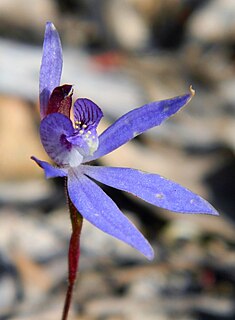
Caladenia caerulea, commonly known as the eastern tiny blue china orchid, blue caladenia or blue fairy is a plant in the orchid family Orchidaceae and is endemic to eastern Australia. It has a single narrow leaf and a single blue flower.

Passiflora × violacea, the violet passion flower, is a hybrid between two species of flowering plants, Passiflora racemosa × Passiflora caerulea, in the family Passifloraceae. The name Passiflora × violaceae has yet to be resolved as a correct scientific name; nevertheless it is widely found in the horticultural literature.
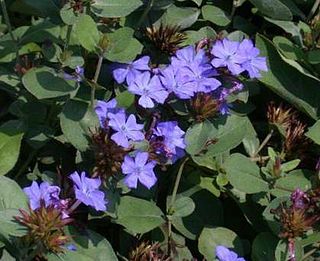
Ceratostigma plumbaginoides (蓝雪花), the hardy blue-flowered leadwort, is a species of flowering plant in the plumbago family, native to Western China, where it is usually found in rocky foothills.

A graphite pencil, also called a lead pencil, is a type of pencil in which a thin graphite core is embedded in a shell of other material. The pencil shell is mostly wooden, but can be made of plastic or recycled paper.
















